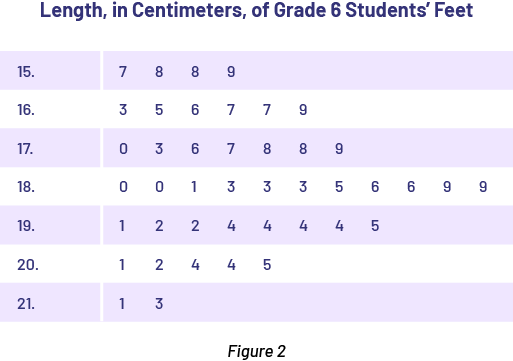D1.1 Describe the difference between qualitative and quantitative data, and describe situations where each would be used.
Skill: Describing the Difference Between Types of Data
There are many kinds of data, and each kind can affect how it is collected and organized. In the junior grades, students need to understand the difference between qualitative and quantitative data, and between primary and secondary data. This understanding helps them to determine what kind of data they will need for their investigation and to plan the collection accordingly.
Source: translated from Guide d’enseignement efficace des mathématiques, de la 4e à la 6e année, Traitement des données et probabilité, p. 49.
In the junior grades, it is important to provide students with a variety of opportunities to plan a data collection. Teachers should question students throughout this stage to help them understand the importance of choosing the right type of inquiry and data to answer the question of interest, as well as the importance of identifying the population to be surveyed and, if necessary, the sample. This will encourage students to develop the critical thinking skills that will be most useful in the fourth stage of the inquiry process.
For example, teachers might ask:
- What kind of data will you collect?
- Will this data help answer your question of interest? Why or why not?
- If you are going to use secondary data, where will it come from? Is this source reliable?
Source: translated from Guide d’enseignement efficace des mathématiques, de la 4e à la 6e année, Traitement des données et probabilité, p. 57-58.
Knowledge: Qualitative Data
Qualitative data are represented by words. For example, if the distribution of junior students' birthdays by season is surveyed with the question "In what season is your birthday?", one of four qualitative responses is expected : spring, summer, fall, or winter. Similarly, the question "What are your favourite hobbies?" is expected to yield responses that are names of activities. In this case, if one anticipates many different responses because of the variety of possible activities, categories (for example, cultural, sports, or leisure activities) can be used to record or organize them.
Source: translated from Guide d’enseignement efficace des mathématiques, de la 4e à la 6e année, Traitement des données et probabilité, p. 49.
Questions of Interest that Require Qualitative Data to Answer
- What type of books do students in the class prefer (for example, fiction or non-fiction books, graphic novels)?
- What actions can you take to protect the environment (for example, borrowing or buying used items when possible, reducing food waste, recycling, turning off lights when leaving a room)?
- What types of activities does your community centre offer (for example baseball, soccer, lacrosse, painting, photography, coding, cooking)?
Knowledge: Quantitative Data
Quantitative data are represented by numbers. For example, when asked, "How tall is the plant at the end of the week?" a quantitative response is expected (for example, 5 cm, 15 cm). If many different responses are expected, one can plan to use intervals to record or organize them. For example, if the length of the feet of the students in a class is measured, one can choose to group the data according to intervals (for example, 15.0 to 15.9 cm, 16.0 to 16.9 cm).
Quantitative data are often represented by a stem and leaf plot.
Example
image Figure Two is a table with the title 'Length, in centimeters, of Grade 6 students' feet'. In line 15, the numbers 7, 8, 8, 9 are found. In line 16, the numbers three, five, 6, 7, 7, 9 are found. In line 17, the numbers zero, 3, 6, 7, 8, 8, 9 are found. In line 18, the numbers zero, zero, one, three, three, three, five, 6, 6, 9, 9 are found. In line 19, the numbers one, two, two, 4, 4, 4, 4, five are found. In line 20, we find the numbers one, two, 4, 4, five. And in line 21, we find the numbers one and three.
Source: translated from Guide d’enseignement efficace des mathématiques, de la 4e à la 6e année, Traitement des données et probabilité, p. 50.
Questions of Interest that Require Quantitative Data to Answer
- Are there more birds at the feeder in the morning or afternoon?
- How far can a Grade 4 student jump?
- How many blocks can a Grade 4 student stack in 30 seconds?
